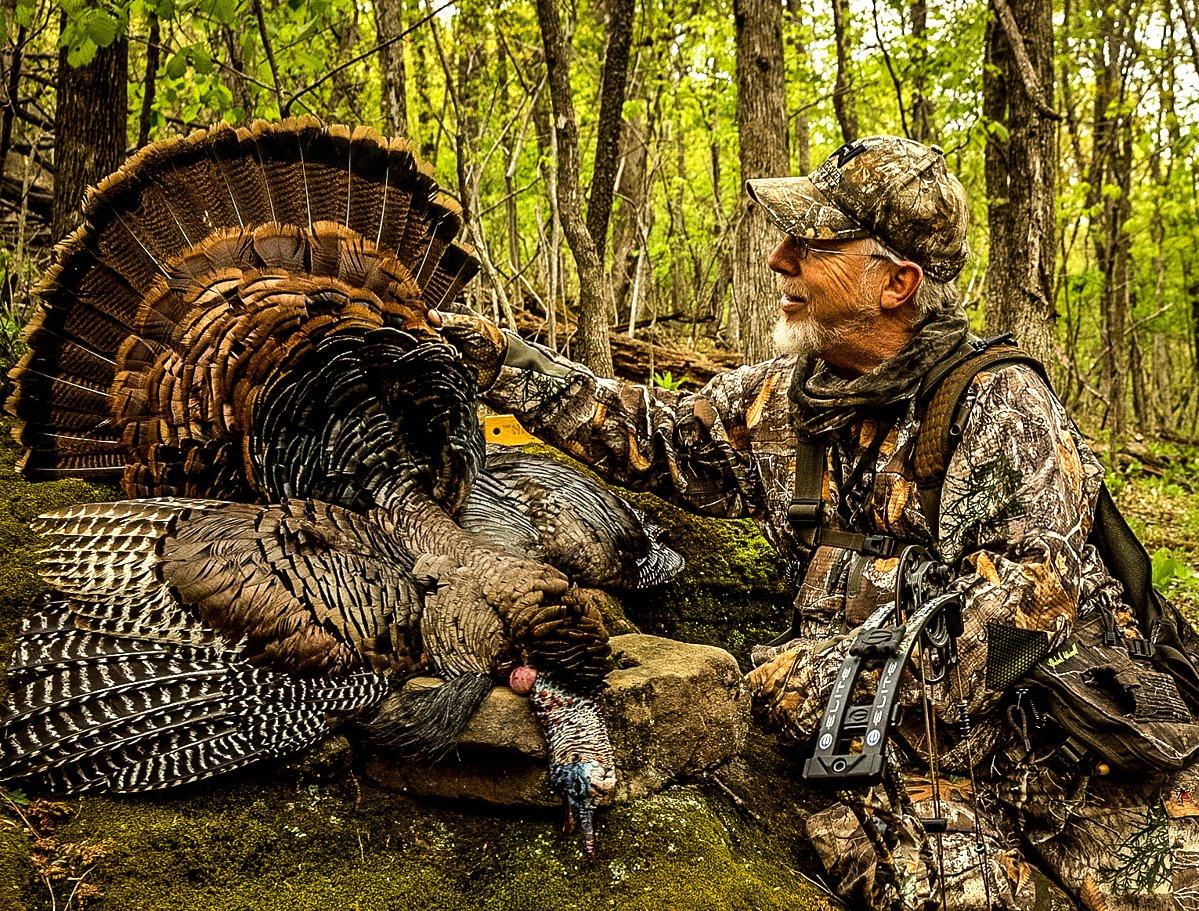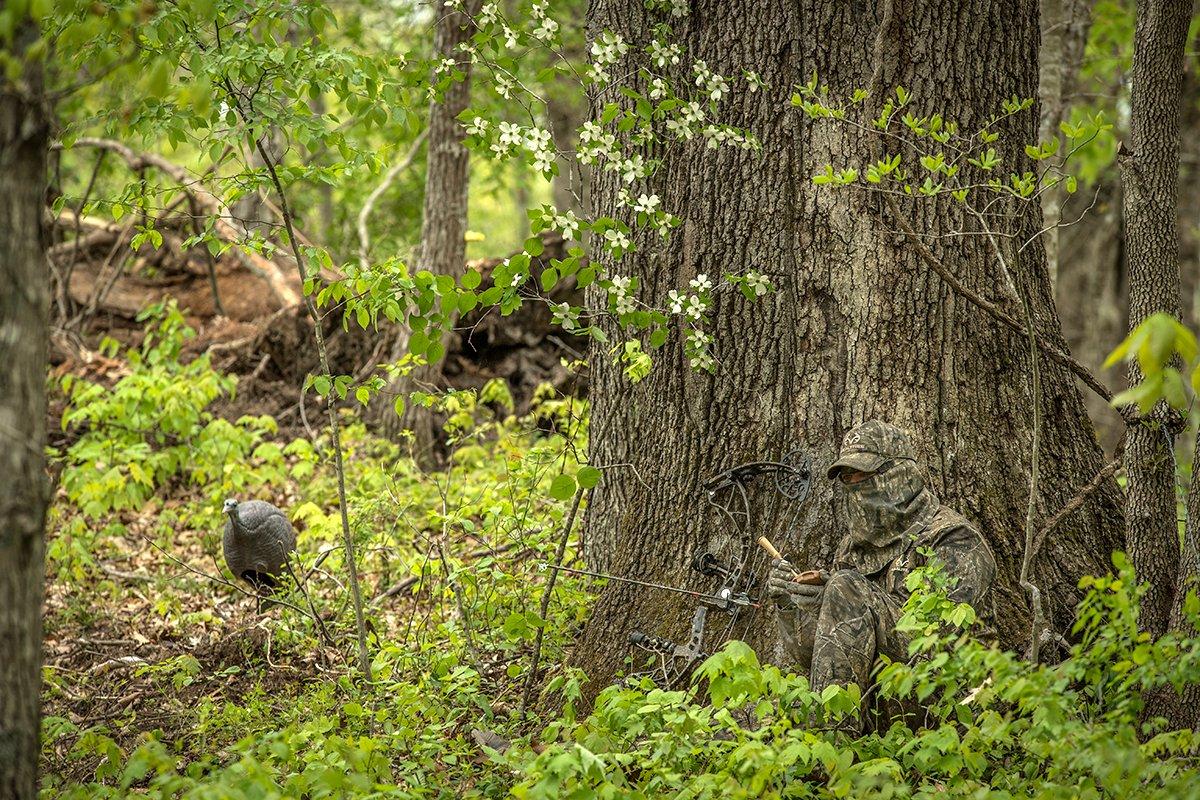Are you ready to put your shotgun down and try to tag a spring gobbler with your bow?
Several toms were sounding off from the roost as I positioned my blind and decoys. I thought I was in for a sure thing but as the morning unfolded, they held up in the timber 150 yards away. After two hours, I grew impatient and decided to hike across the property to see if I could find a more receptive gobbler. It was the final week of the season, and I knew that a lone tom had to be somewhere.
After hiking to the highest point at the opposite end of the field, I called loudly. A tom roared back, gobbling three times in a row. Quickly, I set my hen and jake decoys, then hustled to the field edge, knelt in some grass and nocked an arrow. There wasn't much cover, but I had an Ultimate Predator bow-mounted decoy, and hoped it would be enough.
The tom answered my next few calls from virtually the same location, so I went silent; curiosity kills the cat so many times in the turkey woods. Soon, he was marching right toward my decoys at 25 yards and closing. I easily drew undetected, and when he postured next to my jake decoy, I nailed him. Thump!
Success never comes easy when you're bowhunting turkeys, but getting a gobbler with a bow is an unforgettable thrill. Plus, a few states offer special archery-only seasons that precede regular turkey seasons. That means bowhunters can get the first crack at birds before they're pressured.
Regardless of the reasons why you want to bowhunt turkeys, these tips will improve your odds of success.
(Don't Miss: How to Guide a New Turkey Hunter)
Hunt the Season Phases Accordingly
- Early Season: I've had my most productive hunts by watching flocks from a distance to identify common gathering areas shortly after fly-down. If possible, I'll position a ground blind there in advance, especially if it's close to the roost so I can sneak in to hunt without much commotion. Calling usually isn't needed for this setup. The main thing is to identify where birds want to be, and then be there waiting for them with a realistic jake and hen decoy to trigger jealousy at a point in the spring when birds are really cranked up.
- Mid-Season: As season progresses and flocks disperse, toms can be less predictable. Food options also increase as spring temperatures warm the soil. During this phase, I tend to leave the blind and start hunting on foot. Many gobblers are henned up, and while a tom and his hens might skirt your first setup, you often can make subsequent setups — terrain and cover permitting — and stay in the game. I do a lot of calling during this season phase, especially to the hens since pulling them in can pull in the gobbler, too.
- Late Season: I've seen just about everything during the final days of turkey season. I've hunted a lot of solo toms like the one I referenced above, but I've also hunted toms that were still henned-up. That means I stay flexible. Ideally, I like to pattern a lone tom that's advertising from the same location each morning, but if I cannot locate such a tom, I stay on the move, often using an e-bike to pop in and out of spots and cover hundreds of acres within the first two hours of daylight. In my experience, toms are most vocal during the last week of the season, so if I'm not hearing gobbles, I don't wait around. The good thing is that foliage is thick at this point in the season, which provides concealment for closing the distance and getting hidden when you set up. Late in the season, I do a lot of calling to locate a tom. But after I locate one and set up, I dial it back or shut up altogether if he isn't coming closer. I either let curiosity get the best of him, or I scratch leaves (when possible) to simulate a hen feeding in the timber. I've killed a bunch of turkeys this way.
When Bowhunting is Most Effective
I suggest first-timers bowhunt turkeys from a ground blind, as it will hide the necessary movement of drawing back your bow. That motion is what truly separates bowhunting from shotgun hunting. The other difference is that you must pull the bird in closer. I rarely shoot turkeys beyond 20 yards, and in fact, most of the gobblers I've arrowed have been at 10 yards or less. That should be your goal, both for the in-your-face experience and slam-dunk shot.
Often, the best scenarios for bowhunting occur in agricultural fields where birds are feeding and strutting in the mornings and afternoons. If you don't have such a location, jump in your vehicle and go prospecting. I own zero hunting properties, yet I easily obtain permission to hunt turkeys on agricultural fields every spring.
When I set up in a field, I most often pitch my blind in the middle of the field at the highest point. I do this so my decoys are visible from various locations. Unless they've been highly pressured, turkeys ignore ground blinds, especially if you have a couple realistic decoys set out. By placing a blind in the middle of a field, you have more setup options and better visibility than you would with a field-edge setup.
Decoying and Calling Strategies
Many shotgunners hunt without decoys, and that's OK when a 40-yard shot is a slam dunk. Bowhunting is another matter. You must give the gobbler a reason to wander to within 15 yards and pause for a shot, and decoys are the ticket for that. In fact, I don't suggest bowhunting without them. Buy the most realistic ones you can afford.
You must give the gobbler a reason to wander to within 15 yards and pause for a shot, and decoys are the ticket for that.
On morning hunts, I place my decoys west, north, or south of my blind or ambush. I don't want the eastern sunrise lighting up my ground blind's interior or highlighting me if I'm sitting against a tree. I also don't want sun in my eyes as I try to aim and shoot. Likewise, I set my decoys east, north, or south of my setup on an afternoon/evening hunt. Overlooking this step will either get you busted or add needless difficulty to your shot.
(Don't Miss: Favorite Turkey Decoy Setups of the Pros)
For calling, I keep it simple. When hunting from a blind, I carry a pot-and-striker call and two mouth calls. If I'm hunting without a blind, I usually only carry my mouth calls so that I can call undetected and keep my hands on my bow and release. I focus solely on realism when calling, and stick mostly to yelps, cutts, and purrs. As mentioned earlier, if I'm hunting in the timber, I'll also toss leaves. There's no special science to it. Just try to sound like real turkeys.
Blinds and Archery Equipment
Shop for ground blinds with multiple shooting ports at appropriate heights for bowhunting. Make sure the interior dimensions are roomy enough to easily draw your bow. Also, avoid blinds with clanking zippers, swishy fabrics or hook-and-loop window-closure systems. You might consider the Rhino 180 See Through Blind in Realtree EDGE. It offers a 270-degree adjustable window opening featuring Silent-Slide Window Technology. And, you get a 180-degree unobstructed view through the see-through walls without opening windows.
If you already bowhunt whitetails, you don't really need to make any changes to your setup. Some folks suggest reducing draw weight, especially if your deer bow is at 70 pounds, but I don't touch a thing. I want the ability to shoot the turkey at any angle, and I also want to build confidence during the spring using the identical setup I'll use for big game in fall.
With sufficient draw weight — 50 pounds or more — I believe large mechanical broadheads are best for anchoring a bird. First, the energy unloads onto the bird as the blades open, creating a deadly wallop. Second, turkey vitals are small. You're essentially aiming at a baseball. When you miss the mark, even narrowly, a larger cutting diameter is more forgiving. It can be the difference between severing an artery and a 20-yard recovery or a marginal hit that results in a fly-away episode. I've killed dozens of turkeys with mechanicals and have never been disappointed.
(Don't Miss: The 10 Commandments of Public-Land Turkey Hunting)
Make It Count
To finish, I want to outline the most important part of the encounter: Making the shot. Strutting turkeys appear deceptively big. It's easy to put your pin on the middle of the bird and slap the trigger. That's a good way to wound and lose a turkey, and so I can't underscore it enough: Slow down!
Read the bird's body language. If he's sold on your decoy spread, he'll almost always give you many shot opportunities. Take time to calm down, settle your pin on a specific feather — don't forget to constantly be noting the bird's angle and where your arrow will exit — and squeeze your trigger and follow through. Slow everything down and take your time, and you're much liklier to make a one-shot kill.
(Tag Filled? Try some Bourbon BBQ Fried Turkey Tenders)










